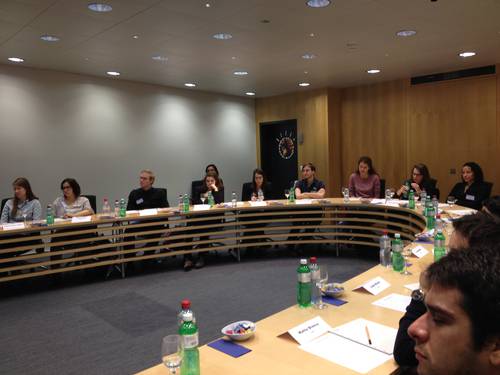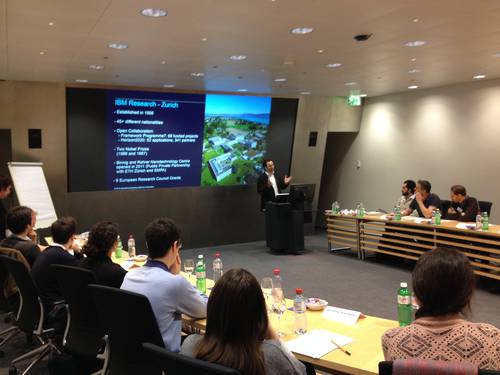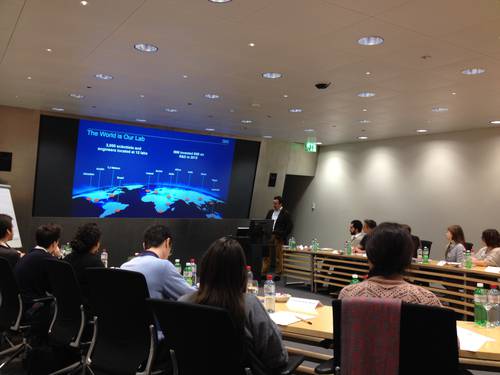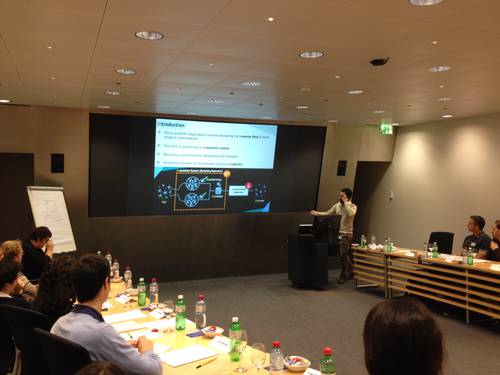Forum des Entreprises
IBM Research - Visit of 28 th January 2016
The Enterprise Day 2016 brought the statistics CUSO PhD student to Rüschlikon in the Zürich suburbs for a visit of IBM Research and an immersion in the world of fundamental research. The complex hosts close to 400 employees many of whom are PhD engineers and researchers. The interdisciplinary research is one of the strength of the firm, a business to business company with global reach which invested 6% of its revenue in R&D in 2015 and has a very nationally diverse employee pool.
The morning was dedicated to introductory presentation, first by Alessandro Curioni, VP Europe and director of the lab who described the various research groups in the facility, namely cognitive computing and industry solutions, cloud and computing infrastructure and finally science and technology. He discussed the location of the firm is due to its proximity to problems and good universities. IBM has been changing rapidly in the last two decades to reorient itself, becoming a business to business company. Some of its better-known services now include cloud computing facilities.
The human resources people emphasized their search of "T-shaped" researchers, meaning people who are top in their field, but also have a broad knowledge of other areas, drive and curiosity. The group listened to the introduction address by the VP Europe and director of the lab, followed by research talks by scientists from the cognitive computing division, giving a broad portrait of the questions IBM Research is trying to answer and the numerical solutions employed in some large data problems, with a focus on parallelization. Many of these are approximation schemes and clever algorithmic design to handle data and reduce computing time to handle bigger and bigger problems.
After lunch break, students were given an overview of the Dome project (https://www.research.ibm.com/labs/zurich/sto/bigdata_dome.html), with a presentation from an EPFL PhD student working at IBM. The participants were exposed to the technical challenges associated with the installation of satellite dishes in the desert and of the data management plan. This was followed by a presentation by the head of the cognitive computing lab, explaining how cognitive computers such as Watson, an AI interface, were able to beat American champions at Jeopardy! A demo of the mining possibilities of Watson, which is diverse (mybluemix.net). IBM led projects range from Chef Watson, an AI platform that creates recipes out of lists of selected ingredients, and Watson for Corporate Intelligence, a cognitive B2B tool for the sales department. With the increase of computing power and miniaturization (Moore's law), the availability of computing resources for individuals allow more and more development and projects that can later be monetized.
The day concluded with three group visits of three research facilities. The first lab dealt with miniaturization and energy release for miniaturized clusters for the Dome project through clever and cheap configuration. The second was a nanotechnology lab isolated against sound, vibrations and kept at constant temperature. Such installation gives IBM, EMPA and ETH Zurich an edge when dealing with sensible experiments, allowing full control of the research environment for the sensitive measurements. The third lab dealt with quantum computing, which is still at an experimental level, where they begin testing 2-qubit chips.
Overall, the experience was very positive and the doctoral students felt well received and their visit was well organized, with a diverse range of speakers. While the jobs detailed may seem inaccessible to most graduate students, perhaps the algorithmic section, overlooked, is a more promising department for them. The immersion into an active research environment was a very stimulating experience and may help students grasp some of the upcoming scientific challenges.
La journée des entreprises 2016 de la CUSO a mené les doctorants de statistique à Rüschlikon pour une visite des installations d'IBM Research. Cette dernière compte 400 employés, beaucoup d’entre eux sont chercheurs et ingénieurs en sol suisse. Compagnie axée sur les opérations entre entreprises (B2B), IBM a fait un choix stratégique pour sa survie sur le long terme : une réorientation vers les solutions cognitives, axées sur les clients en même temps que le pari de la recherche fondamentale et l'innovation. Le directeur du centre a entamé la journée par la présentation des principaux départements de recherche, soient calcul cognitif et solution industrielle, l'informatique dématérialisée et les infrastructures de calcul et la branche sciences et technologies.
L'entreprise recherche des chercheurs sur le « modèle T », motivés, curieux, à la fois dotés d'une expertise très pointue et d'une connaissance large de plusieurs domaines. Les orateurs suivants ont présenté quelques axes de recherche et des travaux sur l'implémentation efficace et en parallèle d'algorithmes, en particulier des approximations inexactes qui permettent une réduction équivalente du temps de calcul et le traitement de problèmes de données volumineuses.
En après-midi, un doctorant de l'EPFL travaillant chez IBM a fait une présentation du projet Dome (https://www.research.ibm.com/labs/zurich/sto/bigdata_dome.html). Les difficultés techniques liées à l'installation de coupoles satellites dans le désert australien et le plan de gestion de données ont été soulignées. Les doctorants ont eu droit ensuite à une présentation des réalisations du superordinateur Watson, connu pour sa victoire au jeu télévisé Jeopardy! contre les meilleurs joueurs. L'intelligence artificielle de l'ordinateur cognitif tient principalement dans sa capacité à forer des données et à faire des recoupements. Cette flexibilité mène à une pléthore d'utilisations possibles qui ont été illustrées par les employés. La journée s'est conclue par une présentation des carrières du chef des ressources humaines et une visite de trois laboratoires. Ces derniers traitaient de miniaturisation des fermes de calcul, du développement expérimental de puces 2-qubit pour le calcul quantique et d'un environnement contrôlé qui absorbe bruit, vibrations et maintient une température constance, et ce, afin d'offrir un meilleur contrôle pour des expériences de nanotechnologie.
L'expérience des doctorants a été positive : plusieurs ont fait part de leur satisfaction face à l'accueil et la sollicitude des hôtes, qui semblent également passionnés. Si les emplois et compétences recherchées semblent inaccessibles pour la plupart des statisticiens du groupe, on peut également regretter le peu d'accent mis sur les aspects algorithmiques où la recherche statistique offre des débouchés d'emploi. L'immersion dans ce milieu de recherche active a été stimulante et très riche sur le plan scientifique, et permet peut-être de comprendre les défis futurs qui nous attendent.






